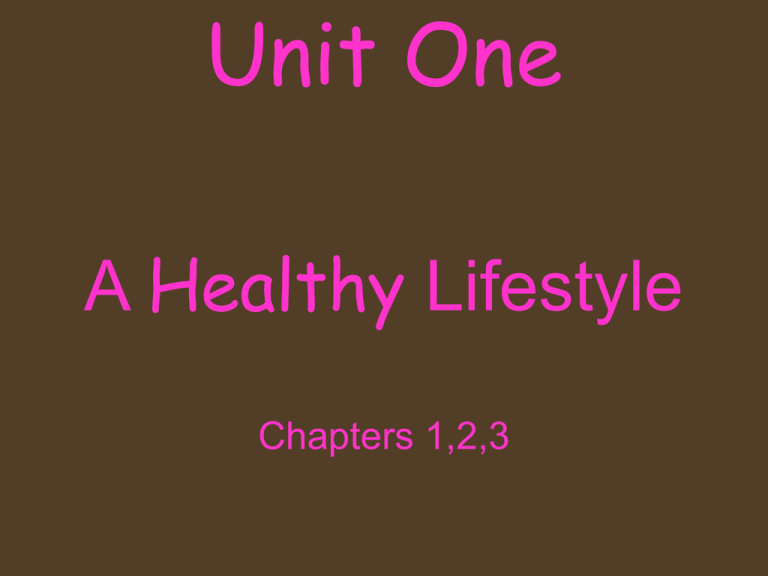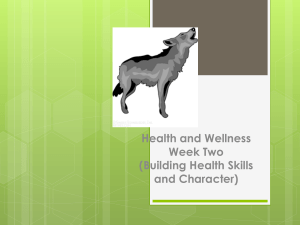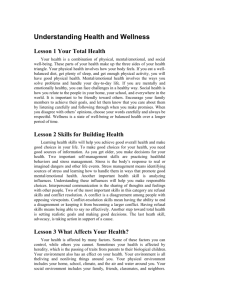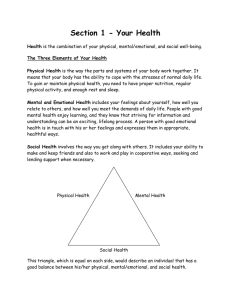Unit One Healthy Lifestyle A Chapters 1,2,3
advertisement

Unit One A Healthy Lifestyle Chapters 1,2,3 Fact or Myth? 1. Teens need more sleep then adults do? 2. Being an effective communicator can improve your health ? 3. The health decisions you make as a teen have little impact on your health as an adult? 4. Two 10 minute walks provide nearly the same health benefits as a continuous 20 minute walk? 5. Water is a nutrient? Fact or Myth? 6. Setting goals can only help you achieve long-tem accomplishments such as establishing a career. 7. Acne flare-ups are a result of eating chocolate and greasy foods 8. Tanning beds are safe because they use UVA light, which doesn’t cause burns 9. All stress is negative and should be avoided. 10. The relationships you have with family, friends and peers do not affect your physical health What is Health? Health is the combination of physical, mental, emotional, social and spiritual well-being. It is not an absolute state. Being healthy means striving to be the best that you can each and every day. The Health Continuum Figure 1.1 (page 5) Where do you fit on the Health Continuum? Yesterday? A month ago? Last year? Health is very dynamic, meaning it is subject to change every single day. Change can be gradual that you’re not even aware that its changing. Wellness Wellness is an overall state of well-being or total health. Wellness comes from a way of living each day that includes making decisions and practicing behaviors that are based on sound health knowledge and healthful attitudes. Achieving wellness requires an ongoing, lifelong commitment to physical, mental, emotional, social and spiritual health. Promoting Good Health The decisions that you make each and everyday will have an impact on your health. What you wear, eat, and do can have personal health consequences that you may or may not have considered. What are some examples? Lifestyle Factors Getting 8 to 10 hours of sleep each night Starting each day with a healthy breakfast Eating a variety of nutritious foods each day Being physically active for at lease 20 minutes a day , three or more days a week. Maintaining a healthy weight Lifestyle Factors Avoiding alcohol, tobacco, and other drugs Abstaining from sexual activity before marriage Managing stress Maintaining positive relationships Practicing safe behaviors to prevent injuries Fitting these health promoting lifestyles factors into your life will help ensure a high level of wellness The key to all of this is PREVENTION!!! Prevention is practicing health and safety habits to remain free of disease and injury Health education is so important!!! Health education is the Providing of accurate health information to help people make healthy choices. A great goal for Health Ed. Is to give people the tools they need to help them live long, energetic, and productive lives. Healthy People 2010 Health People 2010 is a national wide health promotion and disease prevention plan designed to serve as a guide for improving the health of all people in the US. The plan is revised every 10 years, aims to promote health and prevent illness, disability, and early death. Healthy People 2010 Has two main goals Increase quality and years of healthy life for all Americans. Remove health differences that result from facing such as gender, race, education, disability, and location. To reach these goals, individuals, families, and communities must work together. Healthy People 2010 Individuals- can take an active role in their own health. Families- can shape the attitudes and beliefs that result in healthful behaviors. Parents and guardians play an important role in meeting the nation’s health goals when they teach their children the values and skills necessary to maintain good health. Communities- can offer behavior-changing classes such as anti ATOD programs and provide health services. Becoming Health Literate Health literacy- refers to a person’s capacity to learn about and understand basic health information and services and use these resources to promote health and wellness. Health Literacy Health Literate individual needs to be: a critical thinker and problem solver a person who can evaluate health information before making a decision and who knows how to make responsible, healthy choices. A responsible productive citizen a person that can promote the health of the community and who chooses safe and healthful behaviors that are consistent with family guidelines and that shows respect for themselves and others. Health Literacy A self directed learner A person that has developed evaluation criteria for health information. An effective communicator Someone who is above to express his or her health knowledge in a variety of ways. Holistic Health refers to a philosophy of medical care that views physical and mental aspects of life as closely interconnected and equally important approaches to treatment. is actually an approach to life. Rather than focusing on illness or specific parts of the body, this ancient approach to health considers the whole person and how he or she interacts with his or her environment. It emphasizes the connection of mind, body, and spirit. The goal is to achieve maximum well-being, where everything is functioning the very best that is possible. With Holistic Health people accept responsibility for their own level of well-being, and everyday choices are used to take charge of one's own health. Your Health Triangle This health triangle is missing a part which part?? There are FOUR parts to our Health Triangle!!! Spiritual Health- Believing, hoping, having some kind of faith for a balanced life. Physical Health- How well your body is functioning. Mental/Emotional Health- Keeping in touch with your feelings. Dealing with frustrations of everyday life. Social Health- It involves the way to get along with others. Understanding Health Risks Risk Behaviors- are actions that can potentially threaten your health or the health of others. Cumulative Risk- are related risks that increase in effect with each added risk. Example: smoking. Build Health Skills Interpersonal Communication- is the exchange of thought, feelings and beliefs between two or more people. Strategies of effective communications: Clearly say what you mean. use I messages to state your position Pay attention to how you say something Use a respectful tone. Be a good listener Avoid interrupting the speaker, and show that you are listening by nodding or asking appropriate questions. Refusal Skills Refusal skills-are communication strategies that can help you say no when you are urged to take part in behaviors that are unsafe or unhealthful, or that goes against your values. Conflict Resolution Conflict resolution is the process of ending a conflict through cooperation and problem solving. When dealing with a conflict: Take time to calm down and think through the situation. When discussing the conflict, speak calmly and listen attentively, asking questions when appropriate. Use a polite tone and try to brainstorm solutions where no one loses respect. Work it out peacefully. Stress Management Stress Management- ways to deal with or overcome the negative effects of stress. Stress is the body’s and mind’s reactions to everyday demands, a natural part of life. For example being late to class or getting into college. Both equally stressful. The Decision Making Process Decision-making skills are steps that enable you to make a healthful decision. The steps are designed to help you make decisions that protect your rights and health while respecting the rights and health of others. Remember that often you will find it helpful to seek advice from those with more experience such as parents, guardians, teachers or counselors. Steps of the Decision-making Process Figure 2.3 page 34 Step 1: Step 2: Step 3: Step 4: Step 5: Step 6: State the situation List the Options Weigh the Possible Outcomes Consider Values Make a Decision and Act on it Evaluate the Decision Types of Goals Short Term Goal- is a goal that you can reach in a short period of time. Long Term Goal- is a goal that you plan to reach over an extended period of time. Often, short term goals are steps in a plan to achieve a long term goal. Action Plan-multistep strategy to identify and achieve your goals. Achieving Your Goals Follow these steps: Step 1: Set a specific, realistic goal, write it down. Step 2: List the steps you will take to reach your goal. Step 3: Identify sources of help and support. Step 4: Set a reasonable time frame for reaching your goal. Step 5: Evaluate your progress by establishing checkpoints . Step 6: Reward yourself for achieving your goal. What is good Character? Character can be defined as those distinctive qualities that describes how a person thinks, feels, and behaves. A person with good character demonstrates core ethical values, such as responsibility, honestly, integrity, and respect. Development of Your Character Character and core ethical values are learned when you’re young and developed throughout your life. To Develop your character more: Stand up for your beliefs. Learn from people who demonstrate good character traits. Ask family members for tips on how to strengthen values. Join volunteer groups school or community. Form friendships with people who exhibit core ethical values. Development of Your Character Positive Role model- is someone whose success or behavior serves as an example for others. Role models are found with in your own family. Parents, guardians, grandparents, siblings are often people who are your role models. They can inspire and encourage basic values such as hard work, staying focused, planning ahead, being honest, and engaging in safe and healthy behaviors. Where else are role models found? Demonstrating Character By demonstrating good character, you practice behaviors that have a positive effect on both yourself and others at home, at school and in your community. Make a difference at home. Make a difference at school. Make a difference in your community. Questions? Comments?




